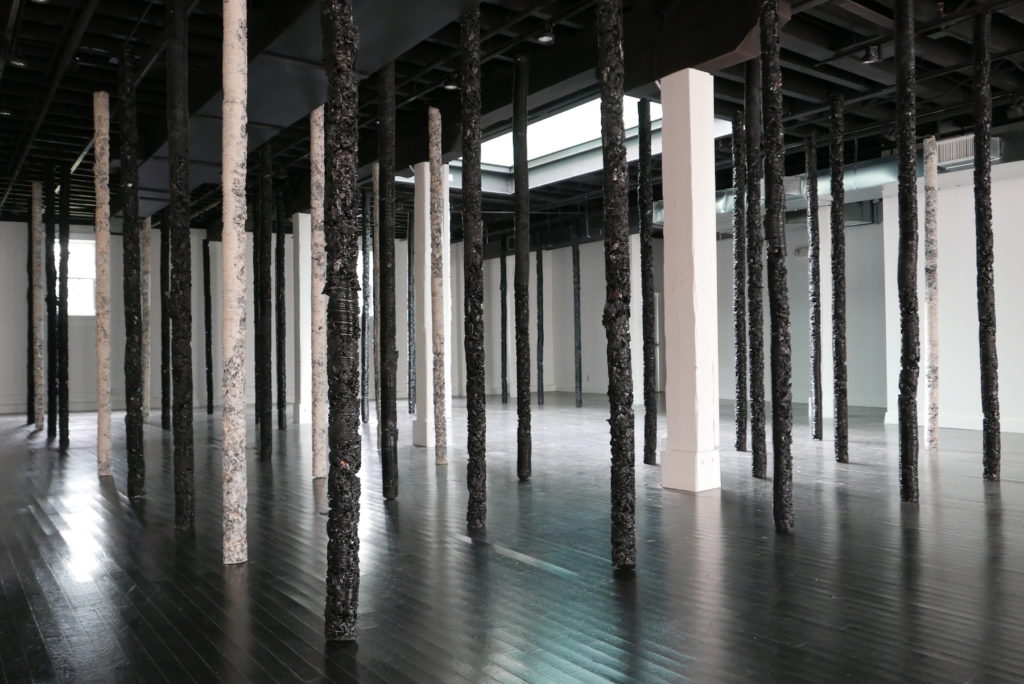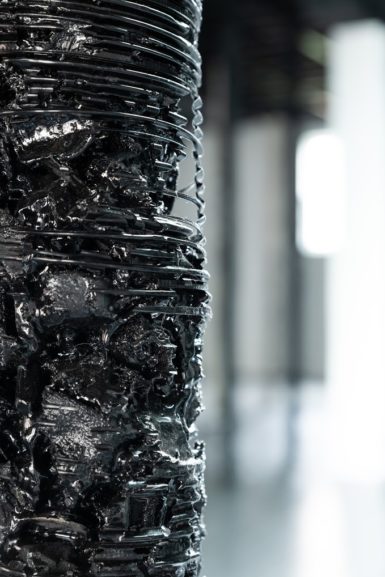[ad_1]

Installation view of “63” by Helmut Lang at Von Ammon Co.
COURTESY VON AMMON CO/VIVIAN DOERING
When Helmut Lang, best known for his dedication to highly structured silhouettes, first said that he would step away from his practice as a fashion designer in 2005, the announcement sent shockwaves through both the worlds of art and fashion. Nearly 15 years later, as the fashion house that retains his name presented a show during New York Fashion Week, Lang mounted an exhibition of sculptures at the recently opened gallery Von Ammon Co. in Washington, D.C.
Titled “63” (after the number of works on view), the presents a curated selection of the more than 200 sculptures that Lang made between 2010 and 2013. For source material, he culled remnants from his archive as a fashion designer to create imperfect columns that soar to the ceiling. Acting as a metaphorical disavowal from his days as a fashion designer, they give off the effect of being extruded from his studio’s trash cans. ARTnews caught up with Lang to talk about the crossover from fashion to art, his friendships with artists Louise Bourgeois and Jenny Holzer, and how to rip it up and start again.
ARTnews: How different is your approach to sculpting from your fashion practice?
Helmut Lang: Both practices are very different regarding surrounding requirements and conditions and purpose. One is basically dealing with direct context with the human body, whereas the other one is actually about building bodies and notions of the figure. My head works always the same way, independent from what I do. It is always difficult to know where to start and always a struggle to know where the right ending is. Every well-done work needs total dedication and investment.
AN: As with this show, you’ve previously destroyed your archives to use as source material. Do you find this process cathartic?
HL: After a long period of consideration, it was mostly a mechanical thing to do to move forward. Along the way, I gave the meaning of an archive a consideration. Louise Bourgeois once said, “Materials are just materials, they are here to serve you.” That is how I see it too.

Installation view of “63” by Helmut Lang at Von Ammon Co.
COURTESY VON AMMON CO
AN: Do you think that dismantling old work is in a way abstracting it?
HL: Yes. That is absolutely true. It will create something new in the process. I didn’t choose the material per se out of desire but as a consequence of a fire we had at in our building in New York that housed our studio.
AN: This continued use of your archive as material seems like a definitive declaration that you’ve switched from fashion to fine art. Any plans to look back?
HL: I have always respected my past and my experiences, but I have always been moving forward throughout my life. It is not healthy to be stagnant or live in the past. I didn’t intend to make a declaration, and I started to make art quite a while before that. But it might have sent out a signal to everyone who was wondering if it were just a phase. There is no plan B.
AN: Your gallery exhibition has been described as your most immersive show to date. What does that mean?
HL: It is the first site-specific installation of the sculptures.
AN: In the past you’ve collaborated with Louise Bourgeois and Jenny Holzer.
HL: We liked each other and out of that common respect, trust, and love developed a natural desire to work together, which was also a great excuse to spend time together.
AN: You met Holzer through the late Ingrid Sischy, the legendary editor of Artforum and Interview. How did that go?
HL: Ingrid was one of the curators of the Art / Fashion program at the Florence Biennale in 1996. She thought that Jenny and I would be a good match for one of the seven artist-designer pairings in Arata Isozaki’s buildings, which he designed specifically for that culture clash. I found out that Jenny lived on the same street, just a few houses down from my apartment in New York, and she invited me over. We both decided during our first encounter that we were not afraid to attack new adventures together.
AN: As a sculptor, who do you look to as a hero? Who inspires you?
HL: I am inspired by the human condition and all its consequences, and for me that is an ongoing occupation unconsciously and consciously reflected in all of my work.
[ad_2]
Source link

